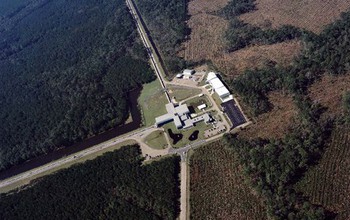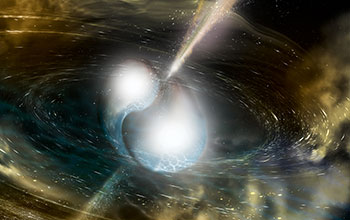All Images
News Release 17-103
LIGO and Virgo make first detection of gravitational waves produced by colliding neutron stars
Discovery marks first cosmic event observed in both gravitational waves and light
This material is available primarily for archival purposes. Telephone numbers or other contact information may be out of date; please see current contact information at media contacts.

Aerial view of the LIGO detector in Hanford, Washington. LIGO research is carried out by the LIGO Scientific Collaboration, a group of more than 1,000 scientists from universities around the U.S. and 14 other countries.
Credit: LIGO Laboratory
Download the high-resolution JPG version of the image. (304.7 KB)
Use your mouse to right-click (Mac users may need to Ctrl-click) the link above and choose the option that will save the file or target to your computer.

Artist's illustration of two merging neutron stars. The narrow beams represent the gamma-ray burst while the rippling space-time grid indicates the isotropic gravitational waves that characterize the merger. Swirling clouds of material ejected from the merging stars are a possible source of the light that was seen at lower energies.
Credit: National Science Foundation/LIGO/Sonoma State University/A. Simonnet
Download the high-resolution JPG version of the image. (1.4 MB)
Use your mouse to right-click (Mac users may need to Ctrl-click) the link above and choose the option that will save the file or target to your computer.
Press conference: First cosmic event seen in gravitational waves and light! NSF brought together scientists from the LIGO and Virgo collaborations, as well as representatives for some 70 observatories, on Monday, Oct. 16, at the National Press Club in Washington, D.C. This is part 1 of the press conference. See also part 2.
Credit: NSF


